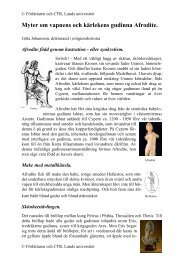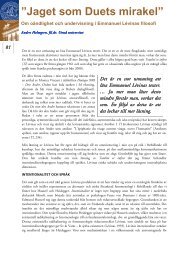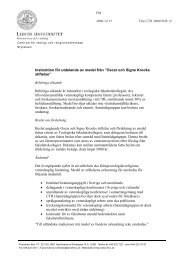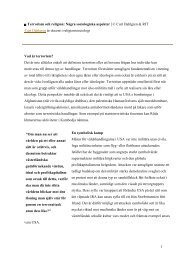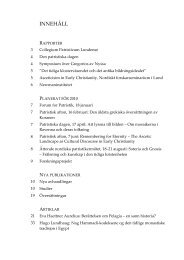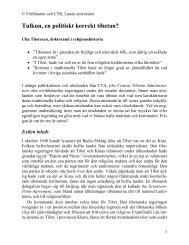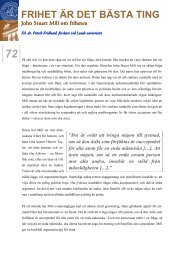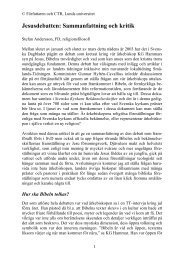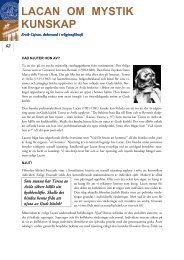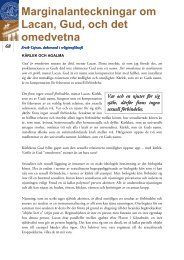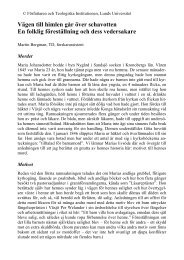Meddelanden 25 (2010) (PDF 2.0 MB - Nytt fönster) - Centrum för ...
Meddelanden 25 (2010) (PDF 2.0 MB - Nytt fönster) - Centrum för ...
Meddelanden 25 (2010) (PDF 2.0 MB - Nytt fönster) - Centrum för ...
Create successful ePaper yourself
Turn your PDF publications into a flip-book with our unique Google optimized e-Paper software.
flation occurred, why does that preclude their later copying by Pachomian<br />
monks, a process that would bring texts with conflated dialects into their<br />
possession? 17 So too one could imagine books entering the federation with<br />
new members. Petronius, who founded the monastery of Thbew, is said to<br />
have donated “sheep, goats, cattle, camels, donkeys, carts, and all that he<br />
possessed, including boats.” 18 Why not also books? And if so, could not the<br />
origin of those books outside of the monastery explain their existence within<br />
it? Finally, I might add that urban production (Khosroyev’s non-traditional<br />
Christians in the cities) does not automatically mean non-monastic production.<br />
Monks lived in cities too. 19<br />
Again, my point is not to prove that the Nag Hammadi codices belonged<br />
to the Pachomian monks, but only that the evidence does not preclude that<br />
possibility. A further question, which I will not pursue here, involves the<br />
meaning to be given to the existence of such a collection within the Pachomian<br />
federation, were it to be proven. Would it make the Pachomians less<br />
orthodox? More heretical? Is that what is at stake? I do not see it that way. I<br />
see no reason to assume that all Pachomians thought alike, or that they believed<br />
everything that they read. I assume that a federation as large as that of<br />
the Pachomians resulted in a diverse population of monks within it: Greek<br />
and Coptic, urban and rural, educated and uneducated, more intelligent and<br />
less intelligent, more philosophical and less philosophical, etc. In such a<br />
world, before a boundary is drawn that separates monks (or books) in terms<br />
of their “orthodoxy,” they existed side-by-side, whether or not they saw eyeto-eye.<br />
The boundary becomes visible only once it is drawn; and once it is<br />
drawn, it necessarily defines reality in the literary accounts that serve to<br />
fashion future monks. 20 I might note in this regard my present work on the<br />
last Coptic orthodox archimandrite Abraham of Farshut. The sources that I<br />
am editing indicate that his removal as head of the federation resulted when<br />
elements within the federation, centered in Lower Egypt, opposed his non-<br />
Chalcedonian orientation. They brought charges against him and succeeded<br />
17 The colophon that follows the Prayer of Thanksgiving in Nag Hammadi Codex VI (65,<br />
8–14) indicates the scribe’s selective choice of the various tractates available to him.<br />
Douglas M. Parrott, Nag Hammadi Codices V, 2–5 and VI with Papyrus Berolinensis 8502, 1 and<br />
(NHS 11; Leiden: Brill, 1979), 389–93.<br />
18 Bohairic Life of Pachomius 56 = First Greek Life of Pachomius 80; translation from Veilleux,<br />
Pachomian Koinonia, vol. 1, 77.<br />
19 Ewa Wipszycka, “Le monachisme égyptien et les villes,” Travaux et Mémoires 12 (1994):<br />
1–44; on the power of the desert imagery to shape the understanding of monasticism, see<br />
James E. Goehring, “The Dark Side of Landscape: Ideology and Power in the Christian<br />
Myth of the Desert,” in The Cultural Turn in Later Ancient Studies: Gender, Asceticism, and<br />
Historiography (ed. Dale B. Martin and Patricia Cox Miller; Durham and London: Duke<br />
University Press, 2005), 136–49.<br />
20 Goehring, “Monastic Diversity and Ideological Boundaries,” 61–84; reprinted in Ascetics,<br />
Society, and the Desert, 196–218.<br />
∙ 66 ∙



